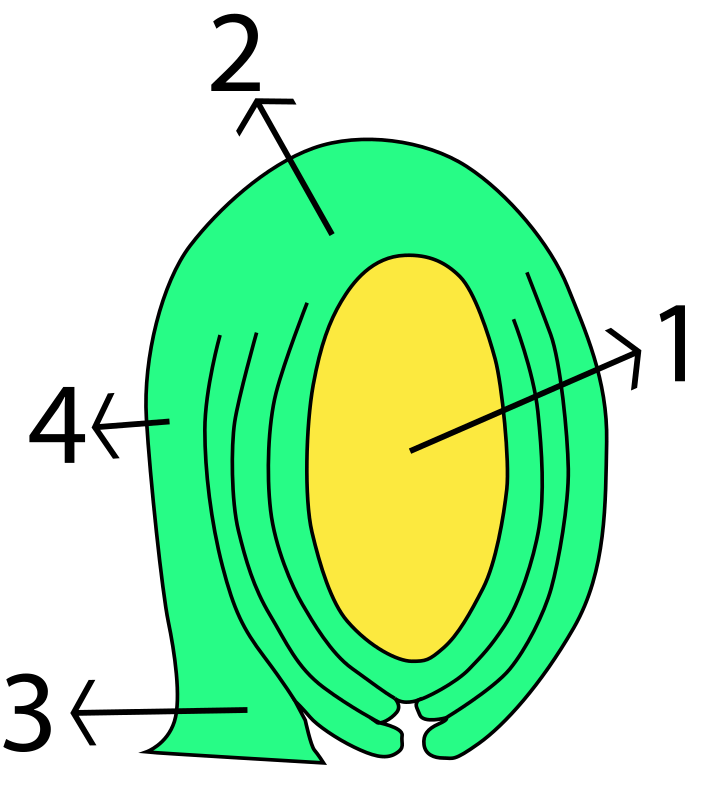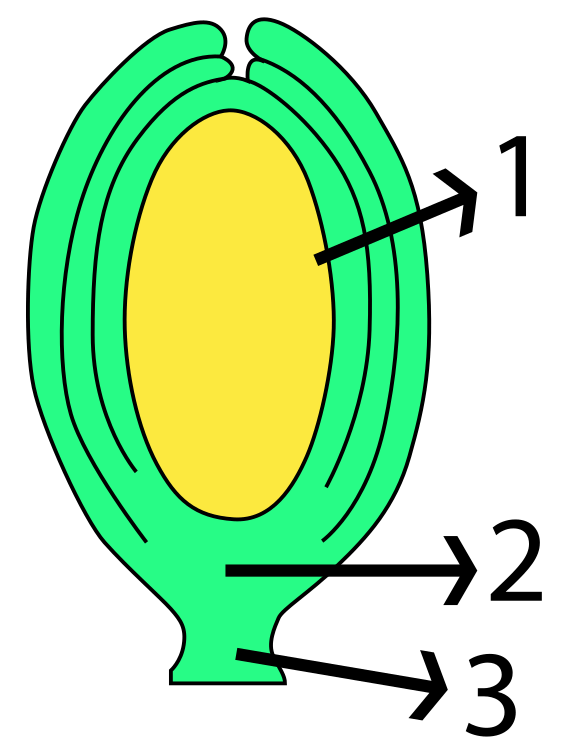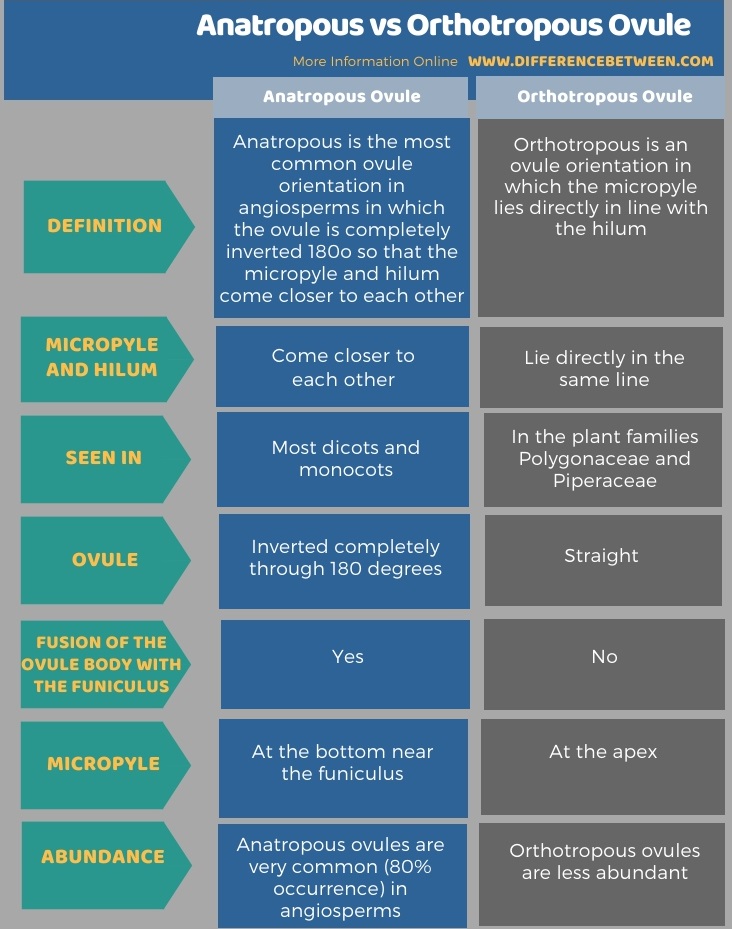Difference Between Anatropous and Orthotropous Ovule
Table of Contents
The key difference between anatropous and orthotropous ovule is that anatropous is the most common ovule orientation in angiosperms in which the ovule is completely inverted in 180o so that the micropyle and hilum come closer to each other. Meanwhile, orthotropous is an ovule orientation in which the micropyle lies directly in line with the hilum.
The ovary is a major part of the female reproductive system of flowering plants. It contains the female reproductive cell or the ovule. The ovule is attached to the inner wall of the ovary by a slender stalk called funicle. The point of attachment of ovule to its funicle is the hilum. Ovule has two major parts as nucellus and integument. The micropyle is a small opening in the integument which allows the pollen tube to enter inside the ovule. Based on the position of micropyle and ovule orientation with respect to the funicle, there are five types of ovules as orthotropous or atropous, anatropous, campylotropous, amphitropous and hemianatropous.
CONTENTS
1. Overview and Key Difference
2. What is an Anatropous Ovule
3. What is an Orthotropous Ovule
4. Similarities Between Anatropous and Orthotropous Ovule
5. Side by Side Comparison – Anatropous vs Orthotropous Ovule in Tabular Form
6. Summary
What is an Anatropous Ovule?
The anatropous ovule is a completely inverted ovule through 1800. Therefore the micropyle and hilum lie close to each other. Therefore, the micropyle comes near the funiculus. The body of the ovule is fused with the funiculus on one side.

Figure 01: Anatropous Ovule (1: embryo sac 2: chalaza 3: funiculus 4: raphe)
Moreover, this is the most common ovule orientation in flowering plants. In more than 80% of angiosperms, anatropous ovules can be seen. Therefore, in most dicots and monocots, anatropous ovules are common.
What is Orthotropous Ovule?
The orthotropous ovule is another type of ovule orientation seen in seed plants. In this orientation, micropyle lies directly in the line of the hilum. Therefore, micropyle, chalaza and funiculus are found in the same line.

Figure 02: Orthotropous Ovule (1: embryo sac 2: chalaza 3: funiculus)
The ovule is straight. Hence, the micropyle is located at the apex. Orthotropous ovules are commonly seen in the plant families: Polygonaceae and Piperaceae. Therefore, compared to anatropous ovules, orthotropous ovules are less abundant.
What are the Similarities Between Anatropous and Orthotropous Ovule?
- Anatropous and orthotropous ovule are two of the five types of ovules seen in seed plants.
- They can be seen in seed plants.
What is the Difference Between Anatropous and Orthotropous Ovule?
Anatropous is the most common ovule orientation seen in angiosperms in which the ovule is completely inverted in 180o so that the micropyle and hilum come closer to each other. On the other hand, orthotropous is an ovule orientation in which the micropyle lies directly in line with the hilum. So, this is the key difference between anatropous and orthotropous ovule. Besides, anatropous ovules can be seen in most dicots and monocots, while orthotropous ovules can be seen in the plant families Polygonaceae and Piperaceae.
Moreover, the anatropous ovule is completely inverted through 180 degrees. In contrast, the orthotropous ovule is completely straight. Also, in the anatropous ovule, the body of the ovule is fused on one side with the funiculus, while it is not fused with the funiculus in the orthotropous ovule. Furthermore, another difference between anatropous and orthotropous ovule is that in the anatropous ovule, micropyle is located at the bottom, near the funiculus while micropyle is seen at the apex in the orthotropous ovule.
Below is a comparison infographic on the difference between anatropous and orthotropous ovule.

Summary – Anatropous vs Orthotropous Ovule
Anatropous ovule and orthotropous ovule are two types of ovules based on the ovule orientation and the position of micropyle with respect to the hilum. The anatropous ovule is a completely inverted ovule through 180 degrees. Therefore, the micropyle can be seen at the bottom very closer to the funiculus. On the other hand, the orthotropous ovule is a completely straight ovule. Hence, the micropyle can be seen at the apex. Moreover, micropyle and hilum lie directly in the same line in the orthotropous ovule. Anatropous ovules are seen in most dicots and monocots, while orthotropous ovules are seen in the plant families of Polygonaceae and Piperaceae. So, this is the summary of the difference between anatropous and orthotropous ovule.
Reference:
1. “Ovule.” Wikipedia, Wikimedia Foundation, 6 Feb. 2020, Available here.
2. “Ovule.” Biology Dictionary, 29 Apr. 2017, Available here.
Image Courtesy:
1. “Ovule morphology anatropous” By biologia.edu.ar, Trace and Color: User:RoRo – biologia.edu.ar (Public Domain) via Commons Wikimedia
2. “Ovule morphology orthotropous” By biologia.edu.ar. Trace and color: User:RoRo – biologia.edu.ar (Public Domain) via Commons Wikimedia
ncG1vNJzZmivp6x7pbXFn5yrnZ6YsqOx07CcnqZemLyue8OinZ%2Bdopq7pLGMm5ytr5Wau26tzZqrq6egpMK0ecCnm2anoqm1sMDRqKeoraNivLfBy55m